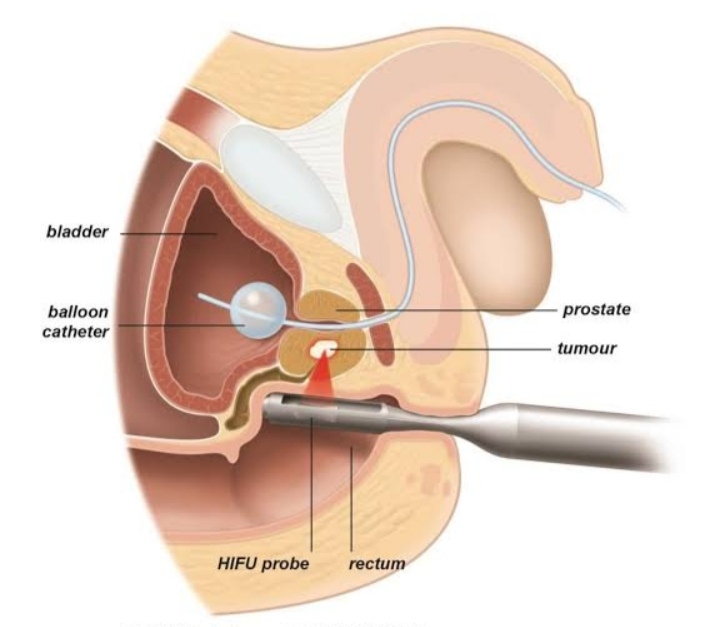Can HIFU treatment be started instantly on every patient?
If you have a large prostate, you will have a hormone treatment 2 to 3 months prior to HIFU procedure. This might downsize prostate and make cancer treatment easier.
Transurethral resection of the prostate (TURP) is a procedure to take out the prostate tissue and improve urine flow. This procure might be used also prior to HIFU to decrease the risk of some post-treatment urine problems.

What are other treatment methods for prostate cancer besides HIFU?
Active surveillance
Active surveillance is a way to monitor slow-growing localized prostate cancer rather than treating it straight away. The goal is to avoid or stall unnecessary treatment and side effects.
Surgical: radical prostatectomy
Radical prostatectomy is surgery to remove the prostate. It may be a surgical treatment option for men with localized prostate cancer.
Radiotherapy
It uses high energy beams like x-rays to treat prostate cancer.
Brachytherapy
It is a procedure that involves placing small radioactive bars in the prostate gland. It is called low-dose rate brachytherapy. Radiation coming from bars destroys cancer cells in prostate.
Yet there are many side effects of these treatment methods. Primary side effects of surgery is urinary incontinence and erection disorder. Side effects of radiotherapy can be problems like tiredness, hair loss, constipation, bleeding, frequent need to urinate and urinary burning.

What are the advantages of HIFU compared to traditional prostate cancer treatment methods (surgical, radiotherapy)?
- Risk of complication is low. It gives the opportunity to intervene cancer tissues without harming the surrounding organ and tissues.
- It provides an important advantage in preserving sexual life and bladder control.
- There is no blood loss and pain.
- There is rapid recovery. Patients are discharged the same day or one day after at most. Whereas they stay in hospital for 3-4 days after surgery.
- It is a nonsurgical procedure. It is a good option for those patients who don’t want to go through surgery or who are not fit for surgery (elderly patients)
- There is no incision.
- It involves no radiation contrary to radiotherapy and it is a one-session procedure.
- Radiotherapy lasts for 30 days and the patients need to come to hospital almost every day.
- Outpatient procedure is conducted.
- HIFU treatment may easily be carried out even after tumor regenerates after surgery, radiotherapy or HIFU treatment.
 Benefits to The Patient
Benefits to The Patient
- Reduced risk of incontinence
- Reduced risk of erectile dysfunction
- Preservation of ejaculation
- Maintenance of prostate tissue
- Minimal invasive procedure
- Shorter period of procedure
- Outpatient treatment
- Rapid recovery
- Goes back to work in a few days.
What kind of preparation is necessary prior to HIFU treatment procedure?
Patient should use antibiotics one day before the procedure and should not eat or during 6 hours prior to the procedure. You will be given enema to empty your bowels in the morning of your HIFU treatment.
How much time does the treatment take?
It lasts for approximately 1,5 – 2 hours yet the procedure time may vary according to the size of the tumor to be burned.
Is HIFU treatment painful?
The treatment itself is not painful since it is carried out under general anesthesia. Rarely there might be post-treatment pain, most patients feel a slight disturbance which heals after a few days. Since the procedure is not interventional there are no incisions or scars.
How much time does it to return to normal life after HIFU treatment?
Our patients are discharged on the day of procedure of after 1 day. Our patients can generally stand up and walk a few hours after the procedure.

What are the side effects of HIFU?
There are far less side effects after HIFU treatment compared to other invasive procedures (surgery, brachytherapy etc.). Side effect rates are much less done by the hands of experienced surgeons.
Though rarely, side effects such as urinary problems, erection and maintenance of erection (erectile dysfunction) are noted in literature.
During focal HIFU procedure, healthy tissues are less harmed compared to whole prostate HIFU, therefore it has fewer side effects than whole prostate HIFU.
Blood and tissue in urine: While catheter is in place, you might see some blood in your urine. 6 to 8 weeks after HIFU procedure, you may see some small prostate tissue in your urine. This is normal. Yet if you get anxious, please consult your doctor.
Erection problems: Very seldom erection and maintaining erection (erectile dysfunction) problems might be observed in some patients after HIFU procedure. The reason for this is that the procedure might harm some blood vessels and nerves that control erection. For some men this is a temporary problem. Yet sometimes the side effect might be a longer-term problem.
Urinary infections: Some men have urinary infections after HIFU procedure. The symptoms of a possible urinary infection are:
- Fever (high temperature)
- Burning feeling when urinating
- Dark or blurred urine with a strong odor
- Need to urinate more frequently than usual
If you have any symptoms of a urinary infections, please consult your doctor. He will generally treat you with antibiotics.
After your treatment
You may go home on the same day of procedure or the next day. Very seldom patients might feel pain, yet you will be given pain relievers that you can take at home.
You will also take antibiotics to prevent any possible infection and you might also be given laxatives to help you empty your bowels.
HIFU procedure generally causes prostate to swell and this might make urinating hard. A catheter will be inserted to help you empty the urine in your bladder until swelling is over (it is generally taken out 5 to 7 days after the procedure).
Your doctor or nurse will show how to use your catheter before you go home.
How is follow-up after the treatment?
Catheter is taken out 3-7 days after the procedure. PSA levels should be checked every 3 months.
In order to check if your prostate cancer is cured or not, you will have prostate MR in specific periods after treatment.
In case of any clinical necessity prostate biopsy might be used to confirm.
If cancer cells are existent, a second HIFU treatment can be used.
CLICK FOR DETAILED INFORMATION... sonacaremedical.com